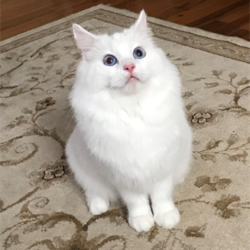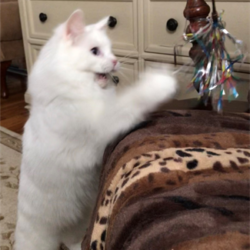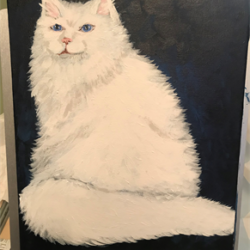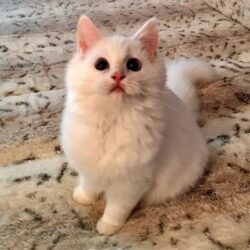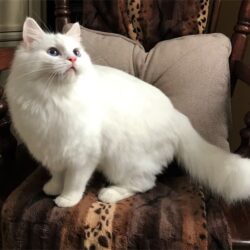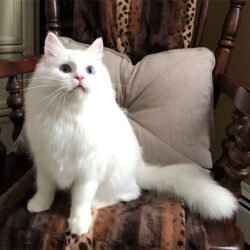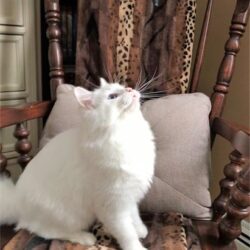
Similar to the Cinnamon, Fawn, Red, Cream, and Tortie Ragdolls, after breeding to true Ragdolls for three generations removed from the foundation cat, these felines are able to receive SBT (Studbook Tradition) designation and recognition as a Ragdoll in TICA. One needs only to look at the lines in a pedigree to determine the origin of a Ragdoll—whether the Ragdoll in question is a descendant of the four Original Ragdolls OR outcrossed to produce a different color.
Most people are apprehensive about acquiring a white cat for the following reason: According to the ASPCA Complete Guide to Cats, “17 to 22 percent of white cats with nonblue eyes are deaf; 40 percent of “odd-eyed” white cats with one blue eye are deaf; and 65 to 85 percent of blue-eyed white cats are deaf.” It is important to realize that NOT all “white” cats are genetically the same. I would not want to purposefully breed a handicapped cat. For this reason, I was, initially, apprehensive myself in choosing to work with this coloration, at least not until I had a firm understanding of the genetics and how to eradicate the possibility of deafness in one of my babies.
As far as what causes deafness in white cats, in some cases, cats actually have colors in their genetic makeup, but they also have a gene that causes a phenomenon, a mutation, called white masking. Blue Eyed White (BEW) Ragdolls have color that is masked by a white coat. This masking covers all other colors and prevents melanin from developing; however, a DNA test, a coat panel, will reveal the genotype of the cat’s true coat color. In addition to this, UC Davis has developed a test for the white spotting factor so breeders will be cognizant of whether or not their cats carry the Dominant White genes and white spotting factor that play a role in causing deafness in cats.
My last BEW Ragdoll female, Sugar, was a Solid Blue Eyed White (N/DW: 1 copy of the Dominant White mutation). That girl was White, without the white spotting factor gene, masking SEAL COLORPOINT (Bb1Dd/cscs). Because she was one color “under” the white masking, she was not deaf and when bred to another colorpoint, the possibility of the presence of the white spotting factor, and deafness, was extremely minuscule. She never produced any deaf offspring. BEW Ragdolls should always be bred to a colorpoint to ensure the white spotting factor is not present to cause the slightest chance of deafness. Responsible, knowledgeable, and humane breeders of the BEWs must be aware of this. I only produced altered pets out of my BEW girl to ensure they were not incorrectly bred by others.
BEW Ragdolls are not actually white! They simply have a white spotting gene that covers their entire body. Their base color is not white, but the masking is so extensive that it makes the cat appear to have completely white fur. This condition really is actually a genetic mutation and can occur in cats that also have white spotting, or are dominantly (but not entirely) white. If the cat has even one hair that is a different color than white, it is not really a white cat, but possesses the white spotting gene. The single colored hair is actually the dominant color.
Cats with white masking and white spotting will, sometimes, have blue eyes. This is because there is color in the genetic makeup, so the eyes are not pink as with that of an Albino cat, which consists of different genes. However, the spotting or masking may have reached the eyes. If the spotting or masking reaches the eyes, it covers the original color so that the eyes appear blue. The reason some blue-eyed white cats are deaf is because the spotting has reached the eyes, and if that is the case, it has most likely also reached the ears. The gene that causes a cat to have a white coat is a dominant white gene. As a result, the cat will have an underlying coat color and pattern. When the dominant white gene is present, however, that pattern will not be expressed. BEW Ragdolls can be colorpoint, mitted, or bicolor “underneath” the white masking. The more white, the more likely deafness is to occur; hence, breeding a BEW that is masking colorpoint TO a colorpoint is ideal to minimize even the slightest possibility of white spotting/deafness. I had a chocolate colorpoint boy that had white under his toes. He carried the white spotting factor. I would not use him with my BEW program.
A cat that is homozygous (WW) or heterozygous (Ww) for this gene will have a white coat despite the underlying pattern/color. A cat that lacks this dominant masking gene (ww) will exhibit a coat colour/pattern. There are several sources for a white cat to have blue eyes. If the underlying coat pattern is one of a pointed cat (also referred to as a Siamese pattern), the blue eyes may come from the genetics of the pointed gene.A common misconception is that all white cats with blue eyes are deaf. It is possible to have a cat with a white coat without this gene, as an extreme form of the white spotting factor.
There is a band of cells, melanocytes, that cause hair growth in the cochleae of the ears and are also present in the vicinity of the neural tube and eyes. Because melanin has an impact on the ionic balance (which effects nerve impulses or vibrations that send messages to the brain to interpret hearing) in the cochlea, the cochlea of the cat that carries the dominant white gene degenerates shortly after birth and the cat is permanently deaf. Sensory hearing loss refers to the inability to convert the vibrations into “neuronal excitation” caused by the loss of sensory hair cells. In deaf white cats, the reason for the hearing loss is sensory in nature. These cats show an inherited degeneration in the cochlea with a domino effect of harmful events resulting in the loss of inner and outer hair cells. Supporting cells in the organ of the complex epithelial structure (the thin tissue lining) in the cochlea, that contains thousands of hair cells and is the main part of the ear where sound waves are perceived, are partially preserved and the auditory nerve degenerates very slowly with age. The involvement of several genes working in lock step together cause deafness. The genetic background is related to the W-locus. The inheritance of deafness can also be a recessive genetic disorder passed down by both parents, but this is different from the cause of deafness in improperly bred BEW Ragdolls. Nobody should be breeding BEW Ragdolls unless they have a clear understanding of the genetics involved with creating healthy BEW kittens without deafness occurring.
Kittens may be checked for deafness using Brainstem Auditory Evoked Response (BAER) testing for animals that measures the electrical activity as the brain receives the auditory stimulus of sound. This should be conducted on breeding cats prior to utilizing them in a breeding program, as well as the BEW Kittens that are produced. Animals must be a minimum of 6 weeks of age, as their hearing pathways are not fully developed before that age. BAER testing is conducted by placing tubal inserts that make sound into both ears and small needles under the skin record the nerve and brain responses to sound taking up to 15 minutes per cat to complete the exam. Sites are listed alphabetically by name of tester, separated into sites in the United States, Canada, and sites outside of North America on this link: BAER Test Sites.
The following veterinarian specialists perform the BAER testing in New York:
NEW YORK
Dr. Judy Pawlusiow
BAER Mobile Testing Service
Advanced Veterinary Mobile Diagnostics, PC
84 Malverne Avenue
Malverne, NY 11565
516-457-2663
BAER.AVMD@gmail.com
www.advancedveterinarymobile.com
www.baermobile.com
Also licensed and testing in NY, NJ, PA, CT, VT, RI, NH, MA, ME, MD.
Drs. Richard Joseph and Jason Berg
Animal Specialty Center
9 Odell Plaza
Yonkers, NY 10701
914-457-4000
www.vcaspecialtyvets.com/animal-specialty-center/Dr. Boaz Levitin
NYC Veterinary Specialists (Manhattan)
410 West 55th Street
New York, NY 10019
212-767-0099, fax 212-767-0098Dr. Ellis Loew
Cornell University College of Veterinary Medicine
Physiology T6-026A
Ithaca, NY 14853
607-253-3484, 607-253-3490 Lab
erl1@cornell.eduDr. Sofia Cerda-Gonzalez
Neurology/Neurosurgery Service
Cornell University Hospital for Animals
Tower Rd
Ithaca, NY 607-253-3060
Works Cited
https://www.canidae.com/blog/2015/11/white-cats-and-deafness-whats-the-connection/
https://www.cell.com/current-biology/pdf/S0960-9822(15)00209-2.pdf
https://www.ncbi.nlm.nih.gov/pmc/articles/PMC3490225/
https://genetics.thetech.org/ask/ask307
https://www.lsu.edu/deafness/baersite.htm
https://www.british-gems.com/copy-of-newshttp://ib.berkeley.edu/courses/ib162/Week3a.htm

